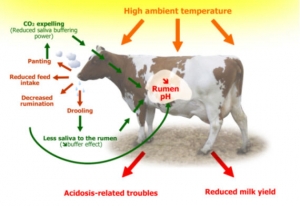Heat stress and cooling systems for dairy cows
Carbohydrates - Keeping Diets Simple While Keeping Production High

This is especially critical during the summer months when cows experience heat stress and high humidity which can occur during many of the months in the summer in Pennsylvania (see figure below).

One option to assure adequate fiber intake but not increase the heat load is to use nonforage fiber sources. Various nonforage fiber sources such as soybean hulls, beet pulp, corn gluten feed, cotton seed hulls, whole linted cottonseed, dried distillers grains, and wheat middlings have been used in the diets of lactating cows to supplement conventional forage fiber. Many of these contain more NDF than some forage sources. One of the major differences between nonforage and forage sources of NDF is particle size. Although differences exist among feedstuffs, nonforage fiber is less effective at maintaining good chewing activity and ruminal health compared with forage fiber of adequate particle size. Therefore when forage NDF is replaced by nonforage NDF it is on the average 50% as effective in stimulating chewing activity and/or milk fat percent as that of forage NDF. The only exceptions are cotton seed hulls and corn cobs which have similar effectiveness to hay. When replacing forage with these by-products rations should be formulated for a higher total NDF level.
When feeding dairy cows adequate pounds of NDF and forage NDF are critical especially for early lactation cows (see table for requirements). One of the most common causes of acidosis occurs when diets are too low in effective fiber or too small particle size. When animals don’t chew their cud normally, lack of saliva (that contains a natural buffer) contributes to low rumen pH. In addition, if starch is too high in the diet or too rapidly fermentable this can also contribute to ruminal upsets, cows reducing intake and reduced butterfat.
Common factors leading to acidosis in dairy cattle:
- Diet too high in fermentable carbohydrates; starch (% ration DM) > 28%
- Concentrate:forage ratio >55%
- Too fast a switch from high forage to high concentrate
- Too fast a switch from silage to high levels of green chop forage
- Low fiber content in diet; < 30% NDF and < 19% forage NDF (% of ration DM)
- Fecal starch DM > than 4%
- Diet composed of very wet and highly fermented feeds; >52% moisture
- Too finely chopped forage; > 5% in bottom pan of PSU particle separator
- Over mixed TMR resulting in excess particle size reduction; > 20% in pan
Forage diagnostics:
NDF and ADF Total NDF intake
% of BW 1.1 – 1.2%
% of total ration 28-33%
lb per day 13-16
Forage NDF intake
% of BW 0.85 - 1.1%
% of total NDF >75%
% of ration DM 18-22%
lb per day 11-13
Total ADF intake
lb per day min 8





















